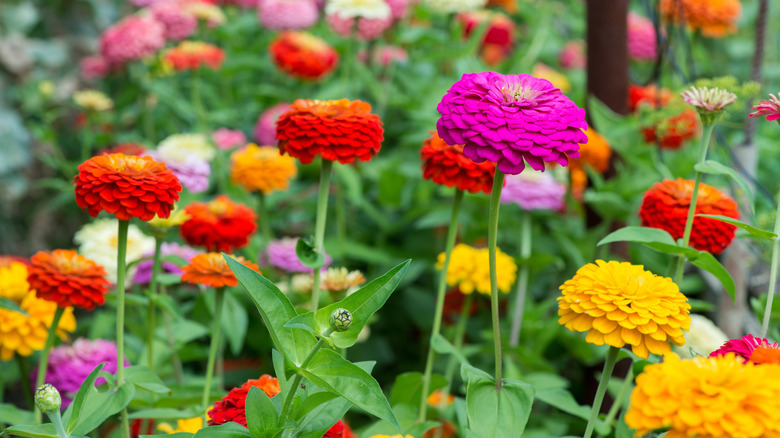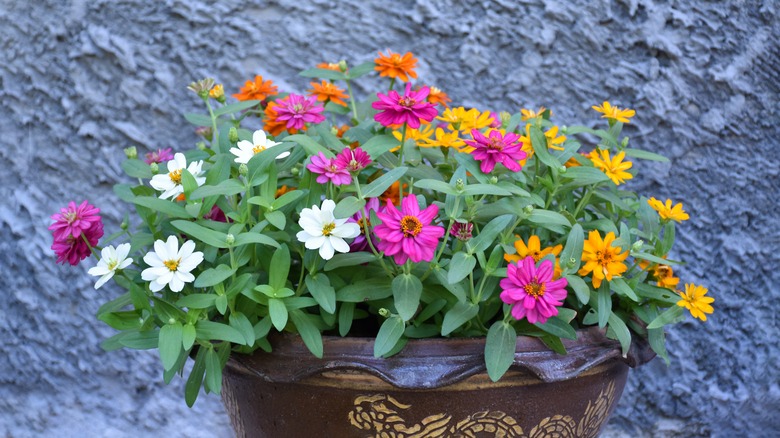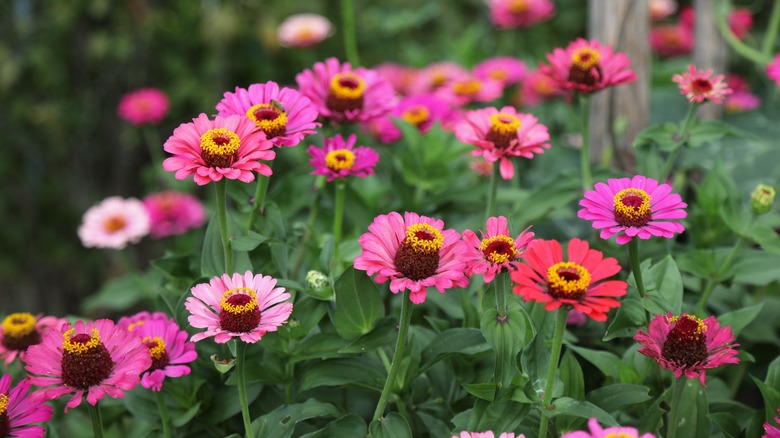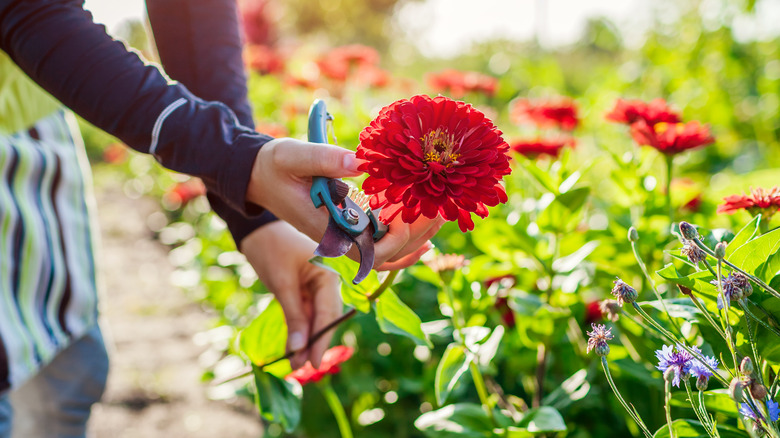Our Professional Gardener's Tips For Planting Zinnias For Season-Long Color
Zinnias are a beloved annual flower and provide weeks of vivid color in the summer garden. In colder areas, they have a short season, as they can't be sown from seed outdoors until well past the last frost date, and the first frost in autumn can decimate them. But there are a few tricks for keeping zinnias blooming in your garden for the whole season, using a variety of approaches including sowing seeds indoors, planting nursery plants, using containers, and choosing assorted varieties.
Zinnias are a tropical plant that are native to South America and the Southwest United States, with many varieties originating in Mexico. Because of their love of heat and sun and their sensitivity to cold, they're grown as annuals in most of the U.S. Some gardeners have luck with zinnias reseeding in their gardens, but if you live in USDA Zone 5 or lower, the seeds might not survive the winter. However, I often collect the seeds in late summer or autumn and plant them the following spring.
The best way to ensure you'll have zinnias blooming over the long summer season is to utilize more than one approach to planting them. If you can start seeds indoors, this is the best way to give your zinnias a head start. Plant them five to seven weeks before the last frost date. If you can't grow indoors, the next best thing is to get nursery-grown plants, which are grown early from seed in the greenhouse.
Should zinnias be planted in containers or beds?
Many gardeners direct sow zinnia seeds in garden beds. Zinnia seeds need plenty of sun and warmth to germinate and grow, so this should be done well past the last frost date. Also check out the mature size of the zinnias you're growing, so you can place taller varieties in the back or center of the bed where they won't hide smaller plants. The taller the plants, the more space you should give them, as these varieties also tend to get larger at the base.
You can also sow the seeds in containers, and the added benefit here is that the soil can warm up faster. Use well-draining potting soil in terra cotta pots to create a warm environment for the seeds to germinate. Some zinnia varieties grow fairly large root systems, so be sure you have room for them. Nursery plants are a bit easier to transplant into containers because the root systems are already developed.
Once your zinnias have grown to at least six inches tall, you can transplant them to other areas in the garden or add them to container plantings. Remember that zinnias are susceptible to powdery mildew on their leaves, so when planning your garden layout, give them space for air circulation. Larger varieties like 'California Giant,' 'Oklahoma,' or 'Benary's Giant' do best in garden beds. I love the smaller varieties for containers, such as 'Lilliput,' 'Thumbelina,' or 'Zahara,' which grow no more than 18 inches tall.
How to give your zinnias a long bloom season
One key to having a long season of zinnia bloom is to sow seeds at intervals instead of planting them all at the same time. Some varieties take longer to mature than others, but most zinnias bloom within 60-70 days after planting from seed. The seeds will germinate faster in warmer temperatures: at 70-75 degrees Fahrenheit, the seeds will germinate in 5-7 days. Direct sowing outdoors usually results in the plants reaching maturity a bit faster, while transplanting zinnias will tend to slow down the growth a bit comparatively.
Most gardeners in northern Zones will tend to directly sow zinnias outside starting in May to ensure that they don't get hit with a late frost. If you sow some zinnia seeds outdoors every two weeks from mid to late May through the end of June, you will have a longer season of bloom. Assuming you don't get an unusually early frost, I have had zinnias keep blooming through late September and often into mid-October.
It's important to water zinnias regularly, but to avoid overwatering them. They're fairly drought tolerant, but if there is a long stretch of hot weather, this may cause them to dry out or droop a bit. Water well when the top two inches of soil feels dry. To help prevent powdery mildew, water them at the base, and prune any leaves showing signs of fungus or disease. Water in early morning or at dusk.
Keeping zinnias blooming
One trick to increase blooms is to start pruning your zinnias as buds are forming but before flowers open. Similar to chrysanthemums and dahlias, "pinching back" your zinnias will cause more flower buds to form, and also keep the plant a bit more compact. Once your taller zinnia varieties reach 12 inches, you can start to pinch back (or cut with snips) the top three to four inches of the plant. Two stems should grow where there was one. I do this every couple of weeks throughout the growing season, so more stems and buds will form, and the plants fill out nicely.
Once zinnias reach maturity and begin flowering, they form blooms quickly. Their fast growth cycle means zinnias benefit from regular deadheading. Deadheading them before the flowers go to seed helps you avoid too many brown or faded petals. You should also cut off any damaged stems, and any leaves affected by powdery mildew, which can spread to the rest of the plant. Keep deadheading throughout the season.
Be sure to harvest some of your zinnias for displays, too. Many people plant zinnias as part of a cutting garden, because the blooms are long-lasting in the vase, and the plants form new flowers quickly. Cutting your zinnias is good for them! Be sure to cut the stem back to the first set of healthy leaves to encourage reblooming. Continual harvesting of your zinnias can help them stay vibrant and productive through the middle of autumn.



